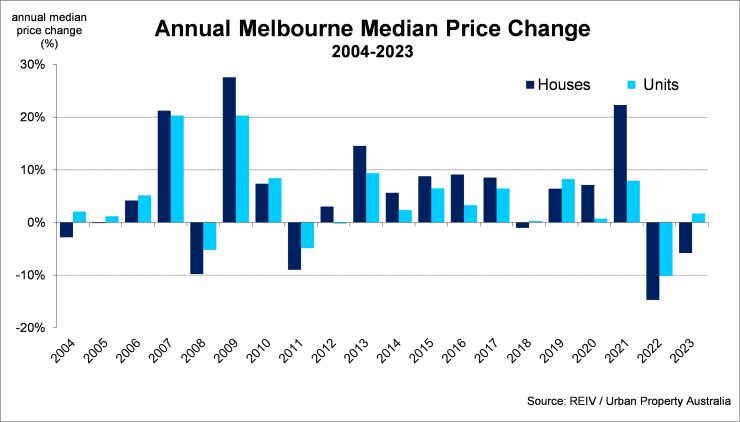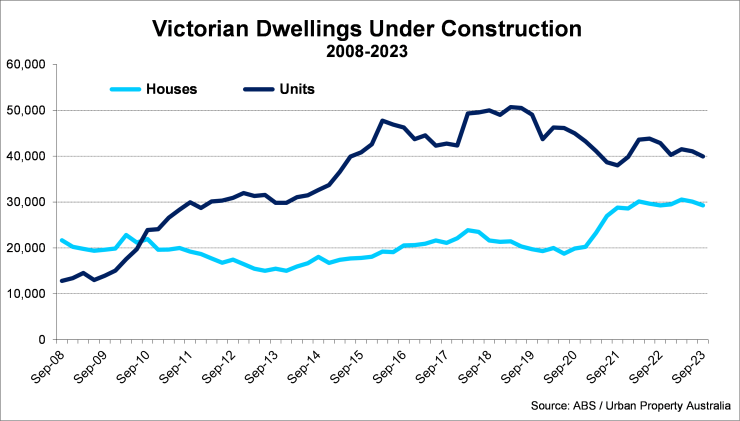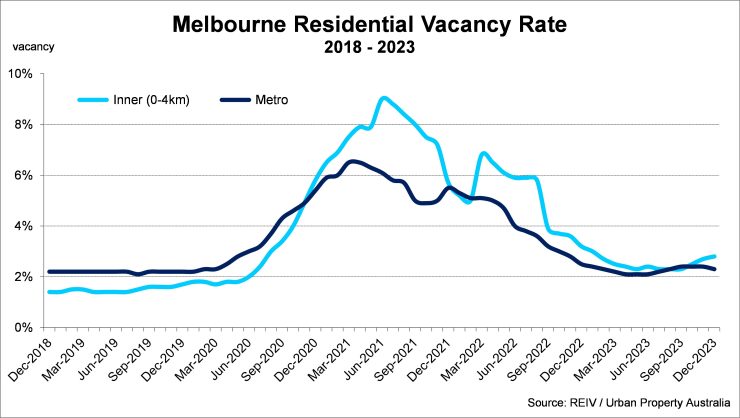Q4 2023 – Melbourne Residential Market
February 1st 2024 | , Urban Property Australia
- Melbourne’s median house price has now declined for eight consecutive quarters, and has now fallen to its lowest level since 2020;
- The number of dwellings under construction across Victoria has fallen over the past 12 months, significantly impacted by the slowdown of high-density apartment development;
- Melbourne residential rental rates grew strongly over the past 12 months with average rents for Melbourne houses up by more than 7% and rents for units up 15%.
Residential Market Summary
Melbourne’s median house price has now declined for eight consecutive quarters, from its peak recorded in December 2021. Melbourne’s median house price has now fallen to its lowest level since September 2020. Although the rate of decreases of Melbourne’s median house price is slowing, the outlook for values remains subdued given the persistent cost of living pressures and worsening affordability challenges. In contrast, reflecting the largely tightening vacancy environment, residential rents have risen to record high levels, increasing by 16% over the year.
Prices
According to the REIV, Melbourne’s median house price has now declined for eight consecutive quarters, from its peak recorded in December 2021. Melbourne’s median house price has now fallen to its lowest level since September 2020. As at December 2023, Melbourne’s median house price was $909,000 according to the REIV, having declined by 2.2% over the quarter and down 5.8% over the year. While Melbourne median unit prices are higher over the year, over the December 2023 quarter also recorded a fall. The Melbourne median unit price has fallen to $632,500 at December 2023. From the peaks recorded, the current Melbourne median house price is now 20% lower while the Melbourne median unit price is 9% lower than the peaks of 2021. Outside of Melbourne, the median Victorian Regional house price rose by 0.9% over the December 2023 quarter to reach $609,500 – its highest level in 12 months. In contrast, the median Victorian Regional unit price continues to fluctuate, declining by 1.1% to $418,000, to remain below the levels recorded 12 months ago. Although the rate of decreases of Melbourne’s median house price is slowing, the outlook for values remains subdued given the persistent cost of living pressures and worsening affordability challenges.

Supply
Despite the Victorian Government’s Housing Statement ambition to build 800,000 dwellings in Victoria over the next decade, the number of dwellings under construction across Victoria has fallen over the past 12 months. According to the ABS, there are currently 69,200 dwellings under construction across Victoria, which is 4% lower than the activity recorded 12 months ago, largely impacted by the slowdown of high-density apartment development. While the number of detached houses currently under construction in Victoria remain close to 10-year highs, the number of apartments currently under construction is 21% down on the peaks of 2019. The level of new dwellings completed in Victoria in the year ahead, is likely to be the lowest level in seven years. Looking forward, with construction prices having risen by 25% over the past three years and higher financing costs, the level of new supply is likely to continue to decrease in coming years. The decline in the pipeline of housing stock is further evidenced by decreasing level of approved dwellings in Victoria with current levels 16% lower than the 10-year average.

Demand
Victoria’s population is growing at record levels, increasing by over 180,000 over year to June 2023, the highest level of any Australian state. Victoria’s population growth was driven by overseas migrants with the state still losing people moving to other states. While total annual Victorian housing finance commitments sit 8% above the 10-year average in November 2023 with $80.3 billion financed, annual levels have fallen by 22% compared to the previous 12 months. Interestingly, monthly finance commitments have increased across all categories in recent months and now all sit above their 10-year average levels and above levels recorded 12 months ago. Owner occupier finance levels increased by 29% over the year led by non-first home buyers with first home buyers’ levels 41% higher than their 10-year average. Investors now account for 30% of total housing finance commitments in Victoria, compared to their share 25% three years ago. Looking ahead, with strong rental growth and a shortage of housing, Urban Property Australia expects that investors will grow their share of housing loans.
Vacancy
According to the REIV, as at December 2023, the vacancy rate for Melbourne residential property has increased to 2.3% up from 2.1% six months ago, however remains below the 10-year average of 3.0%. All precincts’ current vacancy rates now sit below their respective 10-year averages; for most Melbourne’s residential precincts, vacancy rates fell over the year to December 2023, with the exception of the Inner Melbourne region. The vacancy rate of the Outer region recorded the tightest rate at 1.1%, its lowest level in a decade. The Inner Melbourne region (0-10km) holds the highest vacancy rate at 2.8% while the vacancy rate of the Middle region sits at 2.2%. Looking ahead, Urban Property Australia projects that the vacancy rate for the metropolitan Melbourne area will remain low with falling supply levels coupled with population growth of Melbourne currently at record high levels.

Rents
Reflecting the largely tightening vacancy environment, according to the REIV, metropolitan residential rents across the precincts increased over the past year. Over the year to December 2023, the weekly median rent for houses in metropolitan Melbourne increased to $550 per week, up from $513 per week a year earlier. Across Melbourne, rents for houses located in the Outer region increased by 13.0%, with rents in the Inner region increasing by 8.7% and the rents in the Middle precinct rising by 4.6%. Rents for Melbourne units have recorded even stronger rises having increased by 15.2% over the year with unit rents rising across all precincts. Looking forward, Urban Property expects that residential rents will continue to rise, however the growth rates will moderate as affordability pressures begin to impact capacity of renters to absorb the significant growth observed in recent years.
Regional
Median prices appear to have troughed in the Victorian Regional market, median house prices increased over 2023 while median unit prices marginally decreased. In contrast to the performance of median prices in Regional Victoria, rental levels in the Regional markets have remained resilient with the average weekly rental levels for both houses and units sitting at all-time highs as at December 2023. The vacancy rate for Regional Victoria remains very tight at 2.1%, slightly lower than the metropolitan average of 2.3%.
Copyright © 2024 by Urban Property Australia All rights reserved. No part of this publication may be reproduced in any form, by microfilm, xerography, electronically or otherwise, or incorporated into any information retrieval system, without the written permission of the copyright owner.



